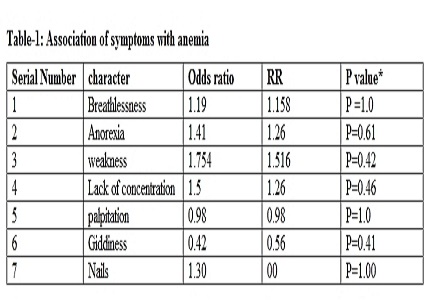Self assessed symptoms and risk factors of anemia in urban school going adolescent girls
Abstract
Introduction: Anemia prevalence is very high in adolescent girls. Anemia detection is not done adequately due to non specific symptoms. Risk factors for anemia have been identified and taken care of but still the prevalence rate remains same.
Methods: A questionnaire based study was conducted at urban school in Kolhapur city in adolescent girls. The questionnaire was filled by the students themselves to find out the symptoms suggestive of anemia. Hemoglobin estimation was done by finger prick method.
Results: 81 girls gave consent to the study. The anemia was present in 70.3% girls, 23% of the girls had severe anemia. There was no association between symptoms (breathlessness, anorexia, and weakness, lack of concentration, palpitation, giddiness, nails, and edema) and anemia. There was no association between risk factors (worm infestations, education of mother and education of father, menstrual problems) and anemia. In severe anemia cases also there was no association between self assessed symptoms and risk factors and anemia.
Conclusion: Prevalence of anemia in adolescent girls remains high. In adolescent girls perception of symptoms of anemia is very poor. Hence there is need to examine hemoglobin concentration actively every year. Education regarding iron rich food should be given. The hemoglobin level of each and every adolescent should be recorded in progress report so as to make students, parents and teachers aware. A hemoglobin day should be observed in the whole country like pulse polio to increase awareness in the community at large.
Downloads
References
2. Policy of control of nutritional anemia .Ministry of health and family welfare, Government of India january1991.www.hetv.org/pdf/anaemia-policy.pdf
3. Shah BK, Gupta P. Anemia in adolescent girls: a preliminary report from semi-urban Nepal. Indian Pediatr. 2002 Dec;39(12):1126-30. [PubMed]
4. Siva PM, Sobha A, Manjula VD. Prevalence of Anaemia and Its Associated Risk Factors Among Adolescent Girls of Central Kerala. J Clin Diagn Res. 2016 Nov;10(11):LC19-LC23. doi: 10.7860/JCDR/2016/20939.8938. Epub 2016 Nov 1.
5. World Health Organization” Maternal, newborn, child and adolescent health: Adolescent development”. URL http://www.who.int/maternal_child_adolescent /topics/adolescence /dev/en. 2015.
6. Thame M, Wilks RJ, McFarlane-Anderson N, Bennett FI, Forrester TE. Relationship between maternal nutritional status and infant's weight and body proportions at birth. Eur J Clin Nutr. 1997 Mar;51(3):134-8.
7. District level household and facility survey. District fact sheet Kolhapur (2012-13).IIPS Mumbai. https://nrhm–mis.nic.in/.../state%20and %and 20%District%20Factsheet
8. Seth T, Hematological disorders. In Ghai OP, Paul VK, Bagga A editors. Ghai Essential Pediatrics seventh ed. New Delhi.CBS Publishers& Distributors private limited 2009.
9. Dutt R, Patil S ,Joshi S, Mhatre R and Dev R, Prevalence of anemia among adolescent girls in rural area of Raigad District, Maharashtra, , Indian J Prev Soc. Med 2009 ;40.
10. Sudhagandhi B , Sunderasan S ,William WE and Prema A, Prevalence of anemia in the school children of Kattankulathur ,Tamil Nadu ,India .International Journal Nutrition Pharmacology, Neurological diseases, 2011Jul 1:1(2):184.
11. Chavda MV , Prajapati JD , Rathod DM , Chaudhary P , Agrawal KM, Screening of novice Adolescent Girls for Anemia studying in Medical and Paramedical Colleges at Civil Hospital Campus , Ahmedabad, Gujarat ,India. Natl J Community Med 2013; 4(2):337-343.
12. Srinivas V, Mankeshwar R. Prevalence and determinants of nutritional anemia in an urban area among unmarried adolescent girls: A community- based cross-sectional study. International Journal of Medicine and Public Health 2015 Oct 1; 5(4):283-6.
13. Teji K, Dessie Y , Assebe T, Abdo M, Anemia and nutritional status of adolescent girls in Babille District ,Eastern Ethiopia ,Pan African Medical Journal, 2016;24(1):62 doi:10.11604/pamj.2016.24.62.6949.
14. Angadi N, Ranjitha A, Knowledge, attitude and practice about anemia among adolescent girls in urban slums of Davangere City ,Karnataka, International Journal of Medical science and Public Health,2016 Mar 1;5:(3):416-20. [PubMed]
15. Thomas D, Chandra J, Sharma S, Jain A, Pemde HK. Determinants of Nutritional Anemia in Adolescents. Indian Pediatr. 2015 Oct;52(10):867-9. [PubMed]
16. Unicef, The adolescent Girls Anemia Control Programme: Breaking the cycle of Undernutrition in India with a focus on adolescent girls. Briefing paper series: innovations, lessons and good practices. New York, UNICEF. 2011.
17. Malhotra S, Yadav K, Kusuma YS, Sinha S, Yadav V, and Pandav CS Challenges in scaling up successful public health interventions: lessons learnt from resistance to a nationwide roll –out of the weekly iron- folic acid supplementation programmed for adolescents in India.
18. Hema PS, Datta SS, Bahurupi YA, Narayan KA, Ambarasan N, Ramya MR. Factors influencing weekly IFA supplementation programme (WIFS) among School Children :Where to focus our attention? International Journal of Contemporary Medical Research 2016; 3(4):1075-1079.
19. Shah SP, Shah P, Desai S, Modi D, Desai G, Arora H. Effectiveness and Feasibility of Weekly Iron and Folic Acid Supplementation to Adolescent Girls and Boys through Peer Educators at Community Level in the Tribal Area of Gujarat. Indian J Community Med. 2016 Apr-Jun;41(2):158-61. doi: 10.4103/0970-0218.173498.
20. Susheela AK, Gupta R, Mondal NK, Anemia in adolescent girls: An intervention of diet editing and counseling. The National Medical Journal India 2016 Jul 1; 29(4):200-4.
21. Salam RA, Hooda M, Das JK, Arshad A, Lassi ZS, Middleton P, Bhutta ZA. Interventions to improve adolescent nutrition: A systematic review and meta analysis. J Adolesc Health. 2016 Oct;59(4S):S29-S39. doi: 10.1016/j.jadohealth.2016.06.022.
22. Suchdev PS, Namaste SML, Aaron GJ, Raiten DJ, Brown KH, Flores –Ayala R, BRINDA Working Group. Overview of the biomarkers reflecting inflammation and nutritional determinants of anemia (BRINDA) Project. Advance in Nutrition: An international Review Journal. 2016 Mar 1; 7(2):349-56.

Copyright (c) 2017 Author (s). Published by Siddharth Health Research and Social Welfare Society

This work is licensed under a Creative Commons Attribution 4.0 International License.


 OAI - Open Archives Initiative
OAI - Open Archives Initiative


